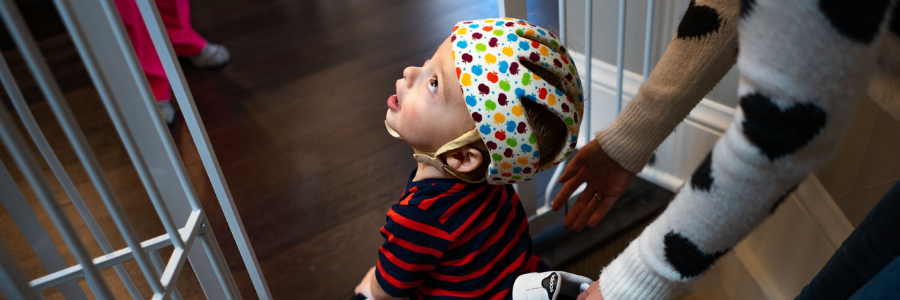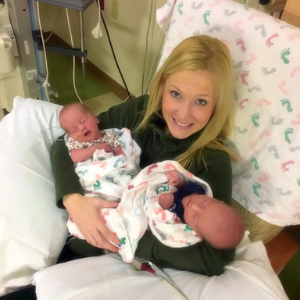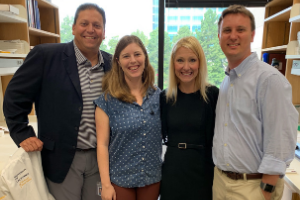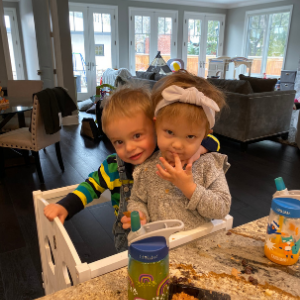Meet Amber Freed, Mother and SLC6A1 Advocate
ASGCT Staff - January 28, 2021
When he was 18 months old, Amber Freed's son, Maxwell, was diagnosed with SLC6A1, a rare genetic disorder that causes seizures, severe movement and speech disorders, and intellectual disability.

In this Q&A, Amber talks about her work as the founder of the advocacy organization SLC6A1 Connect, her partnership with Steven Gray, Ph.D., and what it's like to meet other families dealing with rare diseases.
Can you talk about your decision to start the organization SLC6A1 Connect?
 Mother’s intuition knew something was terribly wrong with Maxwell shortly after birth. Maxwell was limp and didn’t meet developmental milestones like his twin sister, Riley. After an 18 month diagnostic odyssey, Maxwell was diagnosed with SLC6A1 (also known as GAT1). I remember sitting in the bad news room at Children’s Hospital and wondering how my son was diagnosed with something that sounded like a flight number. The compassionate doctors were heartbroken as they explained nothing could be done. Maxwell would have a movement disorder, speech apraxia, intellectual disability, and eventually would develop debilitating epilepsy and lose all of the skills he fought so hard to gain. It was the darkest moment of my life and a sadness for which there are no words.
Mother’s intuition knew something was terribly wrong with Maxwell shortly after birth. Maxwell was limp and didn’t meet developmental milestones like his twin sister, Riley. After an 18 month diagnostic odyssey, Maxwell was diagnosed with SLC6A1 (also known as GAT1). I remember sitting in the bad news room at Children’s Hospital and wondering how my son was diagnosed with something that sounded like a flight number. The compassionate doctors were heartbroken as they explained nothing could be done. Maxwell would have a movement disorder, speech apraxia, intellectual disability, and eventually would develop debilitating epilepsy and lose all of the skills he fought so hard to gain. It was the darkest moment of my life and a sadness for which there are no words.
Inaction was not an option as I held my precious baby that did nothing to deserve such a terrible fate. It was in the diagnostic room that I decided to fight like the third monkey on the deck to Noah’s Ark and it just started to rain. I left my career hours after Maxwell’s diagnosis and haven’t taken a day off in two years.
Once Maxwell was diagnosed, how did you learn more about a disease that’s so rare? What was it like trying to find other families dealing with this disease?
I am a former equity analyst with little background in science, so the learning curve was steep. I gave myself an honorary Ph.D. by reading every textbook and journal article imaginable. My first book was Bioinformatics for Dummies! I spoke to at least 100 scientists the first month after Maxwell’s diagnosis. I had to become the world expert in SLC6A1 in order lead drug discovery efforts.
My family and I made the tough decision to make our personal tragedy as public as possible in order to raise awareness, find other patients, and fundraise. I flooded social media (Facebook, Twitter, LinkedIn) with hashtags, created a family support group, built a website, and began attending conferences wearing a sign that said Help SLC6A1. We have been featured in People, the HuffPost, and CNBC. I was immediately astounded with the number of families afflicted by SLC6A1. New patient families contact me faster than I can reply on a daily basis. SLC6A1 is drastically underdiagnosed because the gene has only recently been included on key testing panels. Our prevalence is 1:38,000. We are the most common syndrome nobody knows (yet). SLC6A1 is the tenth cause of autism and sixth cause of epilepsy, and it plays a major role in many psychiatric conditions. The pathway is also very similar to Parkinson's disease.
I personally take every phone call from newly diagnosed parents and tears run down my face on every phone call as I hear their fear, sorrow, and struggle. Once you see the unmet need for this syndrome, you feel compelled to join our fight. What started as a quest to help my son has transcended my little family and we have the opportunity to help a multitude.
SLC6A1 is drastically underdiagnosed because the gene has only recently been included on key testing panels.
Amber Freed
Are there currently treatment options for SLC6A1? How did you learn about gene therapy as an option?
There were only symptomatic drugs with terrible side effects available when Maxwell was diagnosed. Through my research, I found that gene replacement therapy was the most eloquent treatment option for SLC6A1. SLC6A1 is a monogenic, haploinsufficient, loss of function that fits into AAV9. I then built my dream team of scientists.
How did you get in contact with Steven Gray, Ph.D.?
Dr. Gray is an incredibly busy and accomplished man with endless compassion. After phone calls, emails, and finally surprising him at a conference, we were able to go to dinner. We made a plan together to develop a gene replacement therapy.
What has your partnership with Dr. Gray been like? What have you been able to accomplish since working with him?
 Dr. Gray is an exceptional human being and I have loved working with him. His drive to make this world a better place for children with rare diseases inspires me. We have now partnered with Taysha GTx. Taysha GTx has brought additional horsepower to our project in the form of scientific ingenuity and regulatory expertise with a patient centric focus.
Dr. Gray is an exceptional human being and I have loved working with him. His drive to make this world a better place for children with rare diseases inspires me. We have now partnered with Taysha GTx. Taysha GTx has brought additional horsepower to our project in the form of scientific ingenuity and regulatory expertise with a patient centric focus.
Dr. Gray (pictured on far right with Amber's husband, Mark Freed, Frances Shaffo, Ph.D., and Amber) is focused on advancing therapies as quickly and safely as possible. I love his collaborate nature among peers and the synergies that have emerged. As an example, questions have arisen along the way related to basic science or other translational areas of focus. SLC6A1 Connect has taken the unorthodox approach of funding translational solutions now and backfilling unanswered basic science questions as they come along. Lives are in the balance and the science exists today to advance from bench to bedside.
What is the status of gene therapy for SLC6A1?
The world threw some curveballs at us over the past year, but we continue to make major progress. Science is moving lightening fast in the grand scheme of life. As a parent, treatments can never come fast enough. Our children do not have the luxury of time. Every single day, I tell Maxwell that a treatment is coming and SLC6A1 will simply be a chapter in his book; it will not define him.
How has the pandemic affected your work and how have you adapted?
 The pandemic brought a lot of rare disease research to a halt as resources shifted to COVID-19 efforts and universities closed. While labs were shut down, we were able to pivot our resources to other projects or move research in contract research organizations. Luckily, we were able to identify an FDA approved compound that can be repurposed to help children with SLC6A1.
The pandemic brought a lot of rare disease research to a halt as resources shifted to COVID-19 efforts and universities closed. While labs were shut down, we were able to pivot our resources to other projects or move research in contract research organizations. Luckily, we were able to identify an FDA approved compound that can be repurposed to help children with SLC6A1.
The pandemic has been a frustrating experience for rare disease families. Most of us had to be cautious prior to COVID-19 because something as simple as a cold could result in a hospital stay. As a result of the pandemic, we lost our support system. The army of occupational therapists, speech therapists, physical therapists, equine therapists, and doctor appointments stopped. Telehealth appointments for a three-year-old work as well as putting socks on a rooster. Parents were forced to take triple caretaking duties while juggling work and other children.
Do you have any advice for rare disease patients or their family members who are navigating a similar journey as they look for treatment options? What would you tell them?
There is no roadmap in rare disease. The blessing and the curse is that you are your best advocate. You can let this intimidate you or empower you. Don’t lose hope.
How can organizations like ASGCT help you and others affected by rare diseases?
ASGCT is a powerful organization tirelessly working to advance knowledge, awareness, and education in cell and gene therapies. The ASGCT Annual Meeting is a scientist’s Superbowl! ASGCT can help patients by raising awareness for rare disease. It is important for organizations like ASGCT to highlight rare disease patient stories to show the large unmet need within our communities.
There is no roadmap in rare disease. The blessing and the curse is that you are your best advocate.
Amber Freed
Is there anything else you’d like to add about your work or your experience that people should know?
 The French author Marcel Proust said, “The real voyage of discovery consists not in seeking new landscapes, but in looking with new eyes.” I believe rare diseases hold the path to future innovation on more complex diseases. As the biological pieces come together in the much larger puzzle, I have no doubt there will be a beautiful mosaic in the end.
The French author Marcel Proust said, “The real voyage of discovery consists not in seeking new landscapes, but in looking with new eyes.” I believe rare diseases hold the path to future innovation on more complex diseases. As the biological pieces come together in the much larger puzzle, I have no doubt there will be a beautiful mosaic in the end.
Patient burden on rare disease families is extremely high. Parents are forced to become physicians, scientists, advocates, and full-time caretakers. The rare disease world can be very lonely, isolating, and hopeless. We are so grateful for the selfless scientists that choose to dedicate precious time and resources for our cause.
Related Articles
Maria Santaella, PhD (c), MSN, RN-BC, CPHON serves as the Vice President of Research for the National Bleeding Disorders Foundation. During the workshop she spoke on clinical trial enrollment by sharing strategies to address barriers in recruiting.
Annual Meeting 2024
Inclusive Trial Design Amplifies Patient Voices and Drives Meaningful Outcomes
Samuel Hughes, MBA, St. Jude Children's Research Hospital - June 18, 2024
Patient Perspectives
Rare Village Foundation Lets Rare Disease Families Know They're Not Alone
Devin Rose - October 05, 2023
Patient Perspectives
From Camp to Capitol Hill, Jordan Howard Advocates for Hemophilia
Devin Rose - April 17, 2023
Patient Perspectives
Through the Pain of Fabry Disease, Artist Wes Burian Hasn’t Let Go of Hope
Devin Rose - February 28, 2023